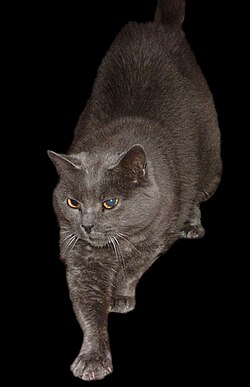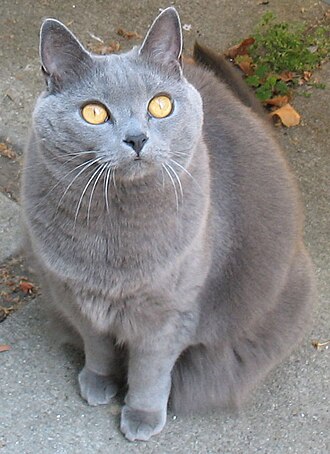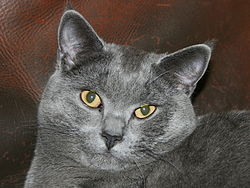Difference between revisions of "AY Honors/Cats - Advanced/Answer Key"
(→Trivia) |
|||
| (One intermediate revision by the same user not shown) | |||
| Line 1: | Line 1: | ||
| − | |||
| − | |||
{| border=1 cellspacing=0 align=right cellpadding=2 | {| border=1 cellspacing=0 align=right cellpadding=2 | ||
|- align=center bgcolor=pink | |- align=center bgcolor=pink | ||
| − | ! | + | !Chartreux |
|- align=center | |- align=center | ||
| − | |[[Image: | + | |[[Image:Chartreux_Cat_1.jpg|225px|Chartreux cat]] |
| − | |||
|- align=center bgcolor=pink | |- align=center bgcolor=pink | ||
!Country of origin | !Country of origin | ||
|- align=center | |- align=center | ||
| − | |[[ | + | |[[France]] |
| − | |||
|- align=center bgcolor=pink | |- align=center bgcolor=pink | ||
!Breed standards (external links) | !Breed standards (external links) | ||
|- align=center | |- align=center | ||
| − | |[http://www.aaceinc.org/ | + | |[http://www.aaceinc.org/pages/breeds/cha.htm AACE], [http://www.cfainc.org/breeds/standards/chartreux.html CFA], [http://www.acfacat.com/breeds/standards/chartreuxstd.html ACFA], [http://www.cca-afc.com/Chad.html CCA], [http://www.acf.asn.au/Standards/Chartreux.htm ACF],<br> [http://www.tica.org/binary/pdf/publications/standards/cxstd.pdf TICA], FIFe |
|} | |} | ||
| − | |||
| − | |||
| − | + | The '''Chartreux''' is an internationally recognized [[cat breed|breed]] of domestic [[cat]] from [[France]]. | |
| + | There is a legend that the Chartreux are descended from cats brought to France by [[Carthusian]] monks to live in the order's head monastery, the [[Grande Chartreuse|Grande Chartreuse]], located in the [[Chartreuse Mountains|Chartreuse Mountains]] north of the city of [[Grenoble]] ([[#Siegal_1997|Siegal 1997]]:27). But in 1972, the [[Prior]] of the Grande Chartreuse denied that the monastery's archives held any records of the monks' use of any breed of cat resembling the Chartreux ([[#Simonnet_1990|Simonnet 1990]]:36–37). Legend also has it that the Chartreux's ancestors were feral mountain cats from what is now [[Syria]], brought back to France by returning [[Crusade]]rs in the 13th century, many of whom entered the Carthusian monastic order. The first documented mention of the breed was by the French naturalist [[Georges-Louis Leclerc, Comte de Buffon|Buffon]] in the 17th century. The first Chartreux were brought to the [[USA]] in 1971. | ||
| + | |||
| + | Physically, the Chartreux is large and muscular, with short fine-boned limbs, big paws, and very fast reflexes. They are known for their [[Blue#Animals|blue]] (grey) double-thickness fur coats and gold- or copper-colored eyes. Chartreux cats are also known for their "smile"; due to the structure of their heads and their long, tapered muzzle, they often appear to be smiling. | ||
| − | + | Chartreux cats tend to be quiet, rarely making noises such as mewing or crying, and some are mute. They are quite observant and intelligent, with some Chartreux learning to operate radio on/off buttons and to open screen door latches. Chartreux cats are playful cats well into their adult years; some can be taught to fetch small objects in the same manner as a dog. Chartreux are good with children and other animals. They are non-aggressive and affectionate, good travelers, and generally very healthy. Chartreux tend to bond with one person in their household, preferring to be in their general vicinity, though they are still loving and affectionate to the other members of the household. | |
| − | + | == Trivia == | |
| − | + | Historically famous Chartreux owners include the French novelist [[Colette]] and French general/president [[Charles de Gaulle]]. | |
| − | + | In 1987, the [[Cat Fanciers' Association|Cat Fanciers' Association]] (CFA) advanced the Chartreux breed to championship status ([[#Siegal_1997|Siegal 1997]]:27). | |
| − | + | The first letter of the official name of a Chartreux cat encodes the year of its birth; all Chartreux born in the same year have official names beginning with the same letter. The code letters rotate through the alphabet each year, omitting the letters K, Q, W, X, Y, and Z. For example, a Chartreux born in 2002 would have an official name starting with the letter T ([[#Fogle_2001|Fogle 2001]]:128). | |
| + | The mascot of the world's largest jazz festival, ''The Montreal International Jazz Festival'', is a blue Chartreux affectionately named 'Ste Cat[http://www.montrealjazzfest.com/fijm2006/images/boutique/acc_enfants_2006/enf_sac_toutou_18_i10_i5B.jpg]', after the festival's hub, 'Sainte Catherine' street in Montreal.Cats are Cool. | ||
| + | [[Image:Chartreux cat J adult female 001.jpg|thumb|left|Adult female Chartreux]] | ||
| + | [[Image:Chartreux JPG01.jpg|thumb|right|The famous Chartreux eyes|250px]] | ||
== References == | == References == | ||
| − | + | <span id="Fogle_2001">Fogle, Bruce (2001). ''The New Encyclopedia of the Cat.'' New York: DK Publishing Inc [Dorling Kindersley]. ISBN 0789980212.</span> | |
| − | + | ||
| − | + | <span id="Siegal_1997">Siegal, Mordecai (1997). The breeds. Chapter 2 in ''The Cornell Book of Cats: A Comprehensive and Authoritative Medical Reference for Every Cat and Kitten''. Second edition. Edited by Mordecai Siegal. Villard:New York. ISBN 978-0679449539.</span> | |
| − | Cat | + | |
| − | + | <span id="Simonnet_1990">Simonnet, Jean (1990). ''The Chartreux Cat.'' Translated by Jerome M. Auerbach. Paris: Synchro Company. ISBN 978-2950600905. (This book's [http://isbndb.com/d/book/chartreux_cat.html ISBNdb.com page] lists "[http://isbndb.com/d/publisher/auerbach_pub.html Auerbach Pub]" as the publisher, but the book itself gives "Synchro Company, Paris" on an unnumbered page immediately following page 190.)</span> | |
| + | |||
| + | == External links == | ||
| + | *[http://www.cfainc.org/breeds/profiles/chartreux.html CFA profile] | ||
| + | *[http://www.chartreux-europe.com Chartreux d'Europe] | ||
| + | |||
| + | {{Commons|Category:Chartreux|Chartreux}} | ||
[[Category:Cat breeds]] | [[Category:Cat breeds]] | ||
| + | |||
| + | [[de:Chartreux]] | ||
| + | [[es:Chartreux]] | ||
| + | [[fr:Chartreux (chat)]] | ||
| + | [[it:Certosino (gatto)]] | ||
| + | [[fi:Kartusiaani]] | ||
| + | [[sv:Chartreux]] | ||
Revision as of 07:07, 20 January 2007
| Chartreux |
|---|

|
| Country of origin |
| France |
| Breed standards (external links) |
| AACE, CFA, ACFA, CCA, ACF, TICA, FIFe |
The Chartreux is an internationally recognized breed of domestic cat from France. There is a legend that the Chartreux are descended from cats brought to France by Carthusian monks to live in the order's head monastery, the Grande Chartreuse, located in the Chartreuse Mountains north of the city of Grenoble (Siegal 1997:27). But in 1972, the Prior of the Grande Chartreuse denied that the monastery's archives held any records of the monks' use of any breed of cat resembling the Chartreux (Simonnet 1990:36–37). Legend also has it that the Chartreux's ancestors were feral mountain cats from what is now Syria, brought back to France by returning Crusaders in the 13th century, many of whom entered the Carthusian monastic order. The first documented mention of the breed was by the French naturalist Buffon in the 17th century. The first Chartreux were brought to the USA in 1971.
Physically, the Chartreux is large and muscular, with short fine-boned limbs, big paws, and very fast reflexes. They are known for their blue (grey) double-thickness fur coats and gold- or copper-colored eyes. Chartreux cats are also known for their "smile"; due to the structure of their heads and their long, tapered muzzle, they often appear to be smiling.
Chartreux cats tend to be quiet, rarely making noises such as mewing or crying, and some are mute. They are quite observant and intelligent, with some Chartreux learning to operate radio on/off buttons and to open screen door latches. Chartreux cats are playful cats well into their adult years; some can be taught to fetch small objects in the same manner as a dog. Chartreux are good with children and other animals. They are non-aggressive and affectionate, good travelers, and generally very healthy. Chartreux tend to bond with one person in their household, preferring to be in their general vicinity, though they are still loving and affectionate to the other members of the household.
Trivia
Historically famous Chartreux owners include the French novelist Colette and French general/president Charles de Gaulle.
In 1987, the Cat Fanciers' Association (CFA) advanced the Chartreux breed to championship status (Siegal 1997:27).
The first letter of the official name of a Chartreux cat encodes the year of its birth; all Chartreux born in the same year have official names beginning with the same letter. The code letters rotate through the alphabet each year, omitting the letters K, Q, W, X, Y, and Z. For example, a Chartreux born in 2002 would have an official name starting with the letter T (Fogle 2001:128).
The mascot of the world's largest jazz festival, The Montreal International Jazz Festival, is a blue Chartreux affectionately named 'Ste Cat[1]', after the festival's hub, 'Sainte Catherine' street in Montreal.Cats are Cool.
References
Fogle, Bruce (2001). The New Encyclopedia of the Cat. New York: DK Publishing Inc [Dorling Kindersley]. ISBN 0789980212.
Siegal, Mordecai (1997). The breeds. Chapter 2 in The Cornell Book of Cats: A Comprehensive and Authoritative Medical Reference for Every Cat and Kitten. Second edition. Edited by Mordecai Siegal. Villard:New York. ISBN 978-0679449539.
Simonnet, Jean (1990). The Chartreux Cat. Translated by Jerome M. Auerbach. Paris: Synchro Company. ISBN 978-2950600905. (This book's ISBNdb.com page lists "Auerbach Pub" as the publisher, but the book itself gives "Synchro Company, Paris" on an unnumbered page immediately following page 190.)
External links
de:Chartreux es:Chartreux fr:Chartreux (chat) it:Certosino (gatto) fi:Kartusiaani sv:Chartreux


